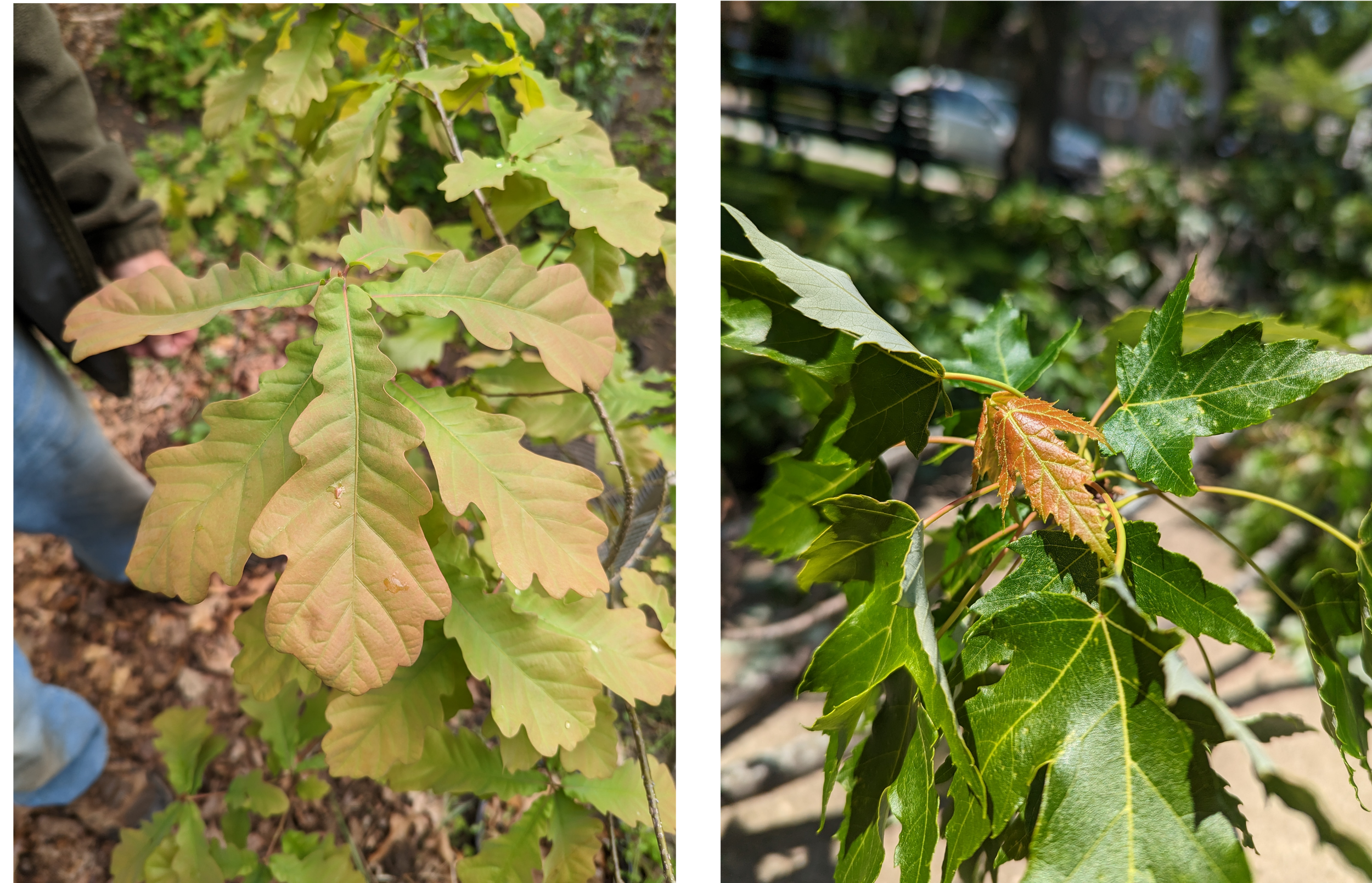Ever notice this in spring or summer? The youngest and newest leaves on many plants have a reddish color? What’s up with that?
Pyrus and Ailanthus summer reddening of new leaves
Certainly this isn’t caused by autumn-like conditions. So why is it that we can so easily find colorful plant foliage during the warm season?
In my example photos, many of these plants aren’t even in the same family. This reddening trait is not unique to only a few plants; it is a very common yet brilliant adaptation amongst many plants.
Trees (and by extension, lots of plants) are very adaptive to different levels of light. To a point, obviously. There are a lot of cool and complex ways the leaves adapt to different levels of light exposure, such as changing their surface area, or thickness. There are other adaptations too, but I’ll be focusing on this one particular adaptation: when new leaves become red, or ‘acyanic’.
Brilliant acyanic Acer and Quercus leaves
An ‘acyanic’ leaf is filled with an additional pigment: anthocyanin. Research into anthocyanins and their roles in plant biology is still ongoing and is fascinating. One of the most well supported claims of this research is that anthocyanins play a protective role for the developing leaf.
Here’s how:
To start, a quick background about pigments and leaf cells. There are many pigments, and many types of leaf cell types, but I’m not covering them all. I’m only going over the ones pertinent to this explanation.
Most of us are familiar with chlorophyll, a pigment that plants rely on for photosynthesis. Pigments are substances that react to light, reflecting the wavelength of light they appear as, while absorbing the rest. Some pigments are photosynthetic, like chlorophyll, while others are not, like anthocyanins. Even without that capability, the way anthocyanins protect leaves is pretty awesome, which we’re getting to.
Below is a basic mesophyll cell, or a cell near the leaf surface. Its primary function is to photosynthesize. Labeled are the relevant cell organelles to this explanation, many others have been omitted for the sake of making the image simple.
Basic photosynthetic leaf cell, categorically called a mesophyll
Chlorophyll, the main green pigment, is contained in a cell organelle called a chloroplast. This is where sunlight is harvested and is used in the creation of sugars.
Anthocyanin, the pigment responsible for the reddish color in new leaves, is formed in the vacuole, which is basically a big sack of water used for various things.
A leaf (and by proxy, leaf cells) can only handle a certain amount of light in a given photoperiod (which is also influenced by other environmental factors beyond just sun exposure). When a leaf hits the limit of light it can handle, one can say the leaf has reached ‘photosynthetic saturation’.
As the leaf expands and the photosynthetic machinery is “setting up” within the chloroplasts, delicate new leaves in high light exposure can become over-productive, and can quickly reach saturation. Photosynthesizing beyond saturation can lead to temporary or permanent leaf dysfunction, which could be pretty bad (one such dysfunction is called photoinhibition).
Quercus and Acer leaves at different stages of acyanicism. The oak leaf is nearly completely mature, and is losing its reddish tint. The maple leaf is very small and is vibrant red.
In order protect vital new leaves, the mesophyll cells do something mind blowing. By injecting anthocyanin pigments into the vacuole of a mesophyll cell, the plant effectively creates an umbrella to shade the developing chloroplasts, pictured below. What?! Take a second to study the picture below.
Anthocyanin shield protecting developing chloroplasts
In other words, in their very cells, the tree leaves adapt to excessive light by using pigments to shade the important parts. An internal shield, or internal umbrella. Some light still gets through, but only enough as to not hit photosynthetic saturation. So insanely cool!
So, when you have millions of cells per leaf with their vacuoles filled with anthocyanins, you get red leaves!
Once the chloroplasts and the rest of the photosynthetic structures are mature enough, the anthocyanin is broken down and reabsorbed by the plant. The leaves then gradually return to their normal color and function. Sometimes those anthocyanins later return during autumn to help protect the chloroplasts once again while the plant reabsorbs the chlorophyll pigment too as they become dormant. They serve the same function in fall.
And that’s just one of the roles anthocyanins play in the leaf. I’d never previously deeply considered that the other pigments, besides chlorophyll, aren’t just for show. They have function, and critically important function at that.
I stumbled into this anthocyanin rabbit hole researching for an entirely different project! But it was too fascinating and alien not to share it with y’all.
Addendum:
There are other reasons that leaves appear red during warmer seasons, besides protecting new leaves. Water deficits can cause a similar appearance, but ultimately it traces back to the same function: protect the photosynthetic apparatus. In the absence of sufficient water supply, the photosynthetic mechanisms function sub-optimally.
Distinguishing this from the new acyanic growth can be a bit tricky. Water deficit symptoms appear on more than just the newest growth. You might more instinctively notice it as “early fall color”. Below are two examples from separate causes.
Only one stem of this maple is showing water deficit symptoms. This case is due to a self-girdling root. The tree is trying to protect the photosynthetic apparatus in the absence of adequate water supply.
Two maples showing water deficit symptoms in a more widespread expression.
I prefer to use the term ‘water deficit’ rather than ‘drought’ because we can have rainy conditions and still have water deficits. For example, in the above two photos, I suspect their water deficits come from highly compacted soils, rather than lack of rainfall. The early fall color symptom is likely to appear before scorching symptoms appear.







